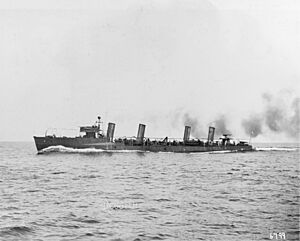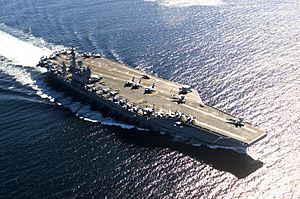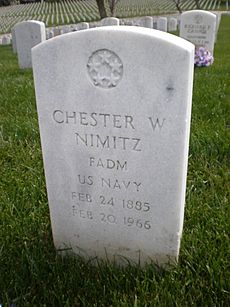Chester W. Nimitz facts for kids
Quick facts for kids
Fleet admiral
Chester W. Nimitz
|
|
|---|---|
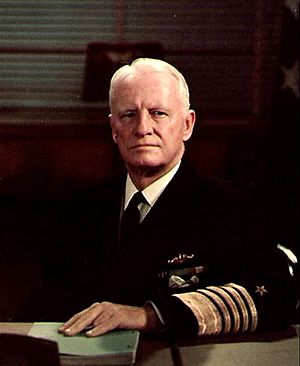
Portrait of Nimitz, c.1945–47
|
|
| Born | February 24, 1885 Fredericksburg, Texas, US |
| Died | February 20, 1966 (aged 80) San Francisco, California, US |
| Buried |
Golden Gate National Cemetery
San Bruno, California, US |
| Service/ |
United States Navy |
| Years of service | 1905–1966 |
| Rank | Fleet Admiral |
| Service number | 5572 |
| Commands held |
|
| Battles/wars | |
| Awards |
|
| Relations | Charles Henry Nimitz (grandfather) Chester Nimitz Jr. (son) |
| Other work | Regent of the University of California |
| Signature | |
Chester William Nimitz (born February 24, 1885 – died February 20, 1966) was a very important fleet admiral in the United States Navy. He played a huge part in the Navy's role in World War II. He was the Commander in Chief of the US Pacific Fleet. He also commanded all Allied air, land, and sea forces in the Pacific Ocean during the war.
Nimitz was a top expert on submarines for the US Navy. Early in his career, he became skilled in submarines. He helped change how submarines were powered, from gasoline to diesel. Later, he was key in getting approval to build the world's first nuclear-powered submarine, the USS Nautilus. Nuclear power soon replaced diesel in US submarines. Starting in 1917, he also developed ways for ships to refuel at sea. This allowed the US fleet to stay at sea for a very long time during the Pacific War. He was the chief of the Navy's Bureau of Navigation in 1939. Nimitz then served as the Chief of Naval Operations from 1945 to 1947. He was the last surviving US officer to hold the rank of fleet admiral. The huge aircraft carrier, USS Nimitz, is named after him.
Contents
Early Life and Education
Nimitz was born on February 24, 1885, in Fredericksburg, Texas. His family was of German descent. His grandfather's hotel there is now the National Museum of the Pacific War. Nimitz's father died before he was born. His German-born grandfather, Charles Henry Nimitz, greatly influenced him. His grandfather had been a seaman and taught him important life lessons. He told Nimitz that the sea, like life, is a tough teacher. The best way to succeed is to learn all you can and do your best. He also said not to worry about things you cannot control.
Nimitz first wanted to join the Army and applied to West Point. But there were no spots available. His congressman, James L. Slayden, had one opening for the United States Naval Academy. He said he would give it to the best student. Nimitz saw this as his only chance for more education. He studied extra hard to get the spot. He was accepted into the Naval Academy in 1901. He graduated with honors on January 30, 1905. He was seventh in a class of 114 students.
Military Career
After graduating, Nimitz joined the battleship Ohio. He sailed on it to the Far East. In September 1906, he moved to the cruiser Baltimore. On January 31, 1907, he became an ensign. This was after two years at sea, as required by law. In 1907, he served on several ships in Asia. These included the gunboat Panay and the destroyer Decatur.
On July 7, 1908, the destroyer Decatur got stuck on a mud bank in the Philippines. Ensign Nimitz was in command. He had not checked the harbor's tide tables. The ship was stuck until the tide rose the next morning. Nimitz faced a court-martial and was found guilty of not doing his duty. But because of his good record and honesty, he only received a warning letter.
Nimitz returned to the US on the USS Ranger. In January 1909, he began training in the First Submarine Flotilla. In May, he was given command of the flotilla. He also commanded USS Plunger. He was promoted to lieutenant in January 1910. He commanded USS Snapper and USS Narwhal. In November 1911, he was put in charge of the 3rd Submarine Division. In February 1912, he took command of USS Skipjack. On March 20, 1912, he saved a sailor from drowning. For this, he received a Silver Lifesaving Medal.
From May 1912 to March 1913, he commanded the Atlantic Submarine Flotilla. Then, he oversaw the building of diesel engines for the oil tanker Maumee.
World War I Service
In the summer of 1913, Nimitz studied diesel engines in Germany and Belgium. He spoke German fluently. He returned to the New York Navy Yard. He became an officer on the Maumee when it was launched on October 23, 1916.
When the US joined World War I in April 1917, Nimitz was the chief engineer of the Maumee. The ship refueled the first US Navy destroyers to cross the Atlantic. Under his leadership, the Maumee performed the first-ever refuelings at sea. On August 10, 1917, Nimitz became an aide to Rear Admiral Samuel S. Robison.
On February 6, 1918, Nimitz became chief of staff for the Submarine Force, US Atlantic Fleet. He received a special commendation for his excellent service. On September 16, he moved to the office of the Chief of Naval Operations. He also became a senior member of the Board of Submarine Design.
Between the World Wars
From 1919 to 1920, Nimitz was an officer on the battleship South Carolina. He then commanded the cruiser Chicago at Pearl Harbor, Hawaii. In 1922, he studied at the Naval War College in Newport, Rhode Island.
In June 1923, he became an aide to the Commander of the Battle Fleet. In August 1926, he went to the University of California, Berkeley. There, he started one of the first Naval Reserve Officer Training Corps (NROTC) units. He pushed for the program to grow.
Nimitz lost part of one finger in an accident with a diesel engine. His Annapolis ring saved the rest of his finger.
In June 1929, he took command of Submarine Division 20. In June 1931, he commanded the destroyer tender Rigel. In October 1933, he took command of the cruiser Augusta. This ship became the flagship of the Asiatic Fleet in the Far East.
In April 1935, Nimitz returned home. For three years, he was assistant chief of the Bureau of Navigation. Then he commanded Cruiser Division 2. In September 1938, he commanded Battleship Division 1. On June 15, 1939, he was made chief of the Bureau of Navigation. During this time, Nimitz continued to test refueling large ships at sea. This skill would be very important for the Navy's success in the coming war.
World War II Leadership

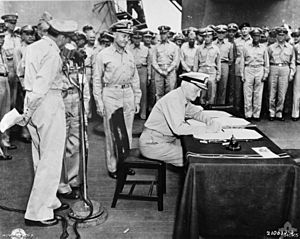
Just ten days after the attack on Pearl Harbor on December 7, 1941, President Franklin D. Roosevelt chose Nimitz. He was to be the commander-in-chief of the United States Pacific Fleet. Nimitz quickly went to Hawaii. He took command on the top deck of the submarine Grayling. He was promoted to admiral on December 31, 1941. Normally, the ceremony would be on a battleship. But all battleships at Pearl Harbor were sunk or damaged. Nimitz took command during a very tough time in the Pacific War. He organized his forces to stop the Japanese advance. He did this even with few ships, planes, and supplies. He had a big advantage: the US had broken the Japanese naval code. This allowed them to read secret Japanese messages.
On March 24, 1942, the US and British leaders decided the Pacific War was America's main responsibility. Six days later, the US military divided the Pacific into three areas. Nimitz was named "Commander in Chief, Pacific Ocean Areas." He controlled all Allied air, land, and sea forces in that area.
Nimitz and his boss, Admiral Ernest King, disagreed with General Douglas MacArthur's plan. MacArthur wanted to attack Japan through New Guinea and the Philippines. Instead, Nimitz and King suggested an island-hopping plan. This plan would let them skip many Japanese strongholds. They would only attack key islands until they reached Okinawa. President Roosevelt allowed both MacArthur and Nimitz to have their own war zones.
Nimitz faced stronger Japanese forces at the Battle of the Coral Sea and the Battle of Midway. The Battle of the Coral Sea was a strategic win. It stopped a Japanese invasion of Port Moresby. Two Japanese aircraft carriers were damaged. This kept them out of the later Midway operation. The Navy's intelligence team learned the Japanese would attack Midway. So, Nimitz moved all his forces to defend it. The Japanese lost many carriers at Midway. This changed the balance of naval power. It was key to stopping Japanese attacks in the South Pacific. Battles during the Battle of Guadalcanal left both sides weakened. But with Allied air power, Guadalcanal was secured. The US then worked to stop other Japanese threats. They built up their forces for bigger naval battles.
The year 1943 was quieter for fighting. But it was important because Nimitz got the supplies and people he needed. This allowed him to launch major attacks in the central Pacific. This push began with the Gilbert and Marshall Islands campaign in late 1943. Then came the destruction of the Japanese base at Truk Lagoon. The Marianas campaign followed, bringing Japan within range of new bombers. Nimitz's forces badly defeated the Japanese fleet in the Battle of the Philippine Sea in June 1944. This allowed the capture of Saipan, Guam, and Tinian. His forces also took Peleliu, Angaur, and Ulithi. In the Philippines, his ships destroyed much of the remaining Japanese naval power. This happened at the Battle of Leyte Gulf in October 1944. Losing the Philippines meant Japan's oil supply routes were threatened. This greatly hurt their war effort.
On December 14, 1944, Congress created the rank of fleet admiral. This was the highest rank in the Navy. The next day, President Franklin Roosevelt appointed Nimitz to this rank. Nimitz took the oath on December 19, 1944.
In January 1945, Nimitz moved his Pacific Fleet headquarters to Guam. This was for the rest of the war. In 1945, Nimitz's forces successfully attacked Iwo Jima and Okinawa. His carriers also raided Japan's home waters. Nimitz also arranged for the Army Air Corps to drop mines in Japanese ports. They used B-29 bombers for this mission, called Operation Starvation. This greatly disrupted Japanese supplies.
On September 2, 1945, Nimitz signed for the United States. This was when Japan formally surrendered on board USS Missouri in Tokyo Bay. On October 5, 1945, "Nimitz Day" was celebrated in Washington, D.C.. President Harry S. Truman personally gave Nimitz another Navy Distinguished Service Medal. This was for his excellent service from June 1944 to August 1945.
After the War
On November 26, 1945, Nimitz was confirmed as Chief of Naval Operations (CNO). On December 15, 1945, he took over from Fleet Admiral Ernest J. King. He had told the President he would serve for one two-year term. He worked hard to reduce the Navy's size after the war. He also made sure the Navy stayed strong and ready.
For the trial of German Grand Admiral Karl Dönitz in 1946, Nimitz provided a statement. He supported the use of unrestricted submarine warfare. Nimitz himself had used this tactic in the Pacific War. This evidence is believed to be why Dönitz received a lighter sentence.
Nimitz also supported a new direction for the US Navy. He backed Captain Hyman G. Rickover's idea to build the USS Nautilus. This was the world's first nuclear-powered ship. The Nimitz Museum in Texas notes that his support for nuclear submarines was a major legacy.
Lifetime Fleet Admiral
Nimitz retired as CNO on December 15, 1947. He received another award for his service. But because the rank of fleet admiral is for life, he stayed on active duty. He received full pay and benefits. He and his wife, Catherine, moved to Berkeley, California. After a fall in 1964, they moved to US Naval housing on Yerba Buena Island in San Francisco Bay.
In San Francisco, Nimitz had a mostly ceremonial job. He was a special assistant to the Secretary of the Navy. He worked to improve relations with Japan after World War II. He helped raise money to restore the Japanese battleship Mikasa. This ship was Admiral Heihachiro Togo's flagship in 1905.
From 1949 to 1953, Nimitz served as a UN-appointed administrator for Jammu and Kashmir. Pakistan accepted his role, but India did not.
Nimitz was also a member of the Bohemian Club in San Francisco. He served as a regent for the University of California from 1948 to 1956. He had previously taught naval science there. The University of California honored Nimitz on October 17, 1964, on "Nimitz Day."
Family Life
Nimitz married Catherine Vance Freeman on April 9, 1913. They had four children:
- Catherine Vance "Kate" (1914–2015)
- Chester William "Chet" Jr. (1915–2002)
- Anna Elizabeth "Nancy" (1919–2003)
- Mary Manson (1931–2006)
Catherine Vance graduated from the University of California, Berkeley. She became a music librarian. She married US Navy Commander James Thomas Lay in 1945.
Chester Nimitz Jr. graduated from the US Naval Academy in 1936. He served as a submariner in the Navy. He retired in 1957 as a rear admiral.
Anna Elizabeth ("Nancy") Nimitz was an expert on the Soviet economy. She worked at the RAND Corporation until she retired.
Sister Mary Aquinas (Nimitz) became a nun in the Order of Preachers. She worked at the Dominican University of California. She taught biology and was an academic dean. She passed away from cancer on February 27, 2006.
Death and Burial
In late 1965, Nimitz had a stroke and pneumonia. In January 1966, he left the hospital to go home. He died at his naval home on Yerba Buena Island on February 20, 1966. This was four days before his 81st birthday. His funeral was on February 24, his birthday. Nimitz was buried with full military honors at Golden Gate National Cemetery in San Bruno, California. He is buried next to his wife and his friends, Admirals Raymond A. Spruance, Richmond K. Turner, and Charles A. Lockwood, and their wives. They had all planned this together.
Ranks Held
 United States Naval Academy Midshipman – January 1905
United States Naval Academy Midshipman – January 1905
| Ensign | Lieutenant junior grade | Lieutenant | Lieutenant commander | Commander | Captain |
|---|---|---|---|---|---|
| O-1 | O-2 | O-3 | O-4 | O-5 | O-6 |
 |
 |
 |
 |
 |
 |
| January 7, 1907 | Never held | January 31, 1910 | August 29, 1916 | February 1, 1918 | June 2, 1927 |
| Commodore | Rear admiral | Vice admiral | Admiral | Fleet admiral |
|---|---|---|---|---|
| O-7 | O-8 | O-9 | O-10 | Special Grade |
 |
 |
 |
 |
 |
| Never held | June 23, 1938 | Never held | December 31, 1941 | December 19, 1944 |
- Nimitz was promoted directly from ensign to full lieutenant.
- He was promoted directly from captain to rear admiral.
- By presidential appointment, he skipped the rank of vice admiral and became an admiral in December 1941.
- Nimitz's rank of fleet admiral was made permanent on May 13, 1946, for his lifetime.
Awards and Honors
United States Awards
| Submarine Warfare insignia | |
| Navy Distinguished Service Medal with three gold stars | |
| Army Distinguished Service Medal | |
| Silver Lifesaving Medal | |
| World War I Victory Medal | |
| American Defense Service Medal | |
| Asiatic-Pacific Campaign Medal | |
| World War II Victory Medal | |
| National Defense Service Medal |
Awards from Other Countries
Orders
| United Kingdom – Knight Grand Cross of the Order of the Bath | |
| France – Grand Officer of the Legion of Honour | |
| Netherlands – Knight Grand Cross of the Order of Orange-Nassau with Swords | |
| Greece – Grand Cross of the Order of George I | |
| China – Grand Cordon of Pao Ting (Tripod) Special Class | |
| Guatemala – Cross of Military Merit First Class | |
| Cuba – Grand Cross of the Order of Carlos Manuel de Cespedes | |
| Argentina – Order of the Liberator General San Martín | |
| Ecuador – Order of Abdon Calderon (1st Class) | |
| Belgium – Grand Cross of the Order of the Crown with Palm | |
| Italy – Knight of the Grand Cross of the Military Order of Italy | |
| Brazil – Order of Naval Merit |
Decorations
| Philippines – Philippine Medal of Valor | |
| Belgium – War Cross with Palm |
Service Medals
| United Kingdom – Pacific Star | |
| Philippines – Liberation Medal with one bronze service star |
Memorials and Legacy
Many places and things are named after Chester Nimitz. He was also honored with a US postage stamp.
- USS Nimitz: This is the first of ten nuclear-powered supercarriers. It was launched in 1975 and is still in service.
- Nimitz Foundation: Started in 1970, it supports the National Museum of the Pacific War.
- The Nimitz Freeway (Interstate 880): A major highway in California.
- Nimitz Glacier: A glacier in Antarctica, named for his service.
- Nimitz Boulevard: A main road in San Diego.
- Fleet Admiral Chester W. Nimitz Gate: The main gate for Naval Base San Diego.
- Nimitz Highway: Hawaii Route 92 in Honolulu.
- The Nimitz Library: The main library at the United States Naval Academy in Annapolis, Maryland.
- Nimitz Hill: A summit on Guam where Nimitz moved his headquarters.
- Nimitz Park: A recreation area at United States Fleet Activities Sasebo, Japan.
- The Nimitz Trail: A trail in Tilden Park in Berkeley, California.
- The Main Gate at Pearl Harbor is called Nimitz Gate.
- Admiral Nimitz Circle: Located in Fair Park, Dallas, Texas.
- Nimitz Hall: The Officer Candidate School barracks at Naval Station Newport, Newport, Rhode Island.
- Nimitz-McArthur Building: Headquarters of the US Pacific Command.
- Nimitz Statue: Designed by Armando Hinojosa, located at the entrance to SeaWorld San Antonio.
- Fleet Admiral Chester W. Nimitz Statue: Near the USS Missouri memorial on Ford Island. It faces the USS Arizona memorial.
Schools Named After Nimitz
- Nimitz High School, (Harris County, Texas)
- Nimitz High School, Irving, Texas.
- Chester W. Nimitz Middle School, Odessa, Texas.
- Chester W. Nimitz Middle School, Huntington Park, California.
- Nimitz Middle School, San Antonio, Texas.
- Nimitz Elementary School, Sunnyvale, California.
- Chester W. Nimitz Elementary School, Honolulu, Hawaii.
- Nimitz Elementary School, Kerrville, Texas.
Images for kids
See also
 In Spanish: Chester Nimitz para niños
In Spanish: Chester Nimitz para niños



